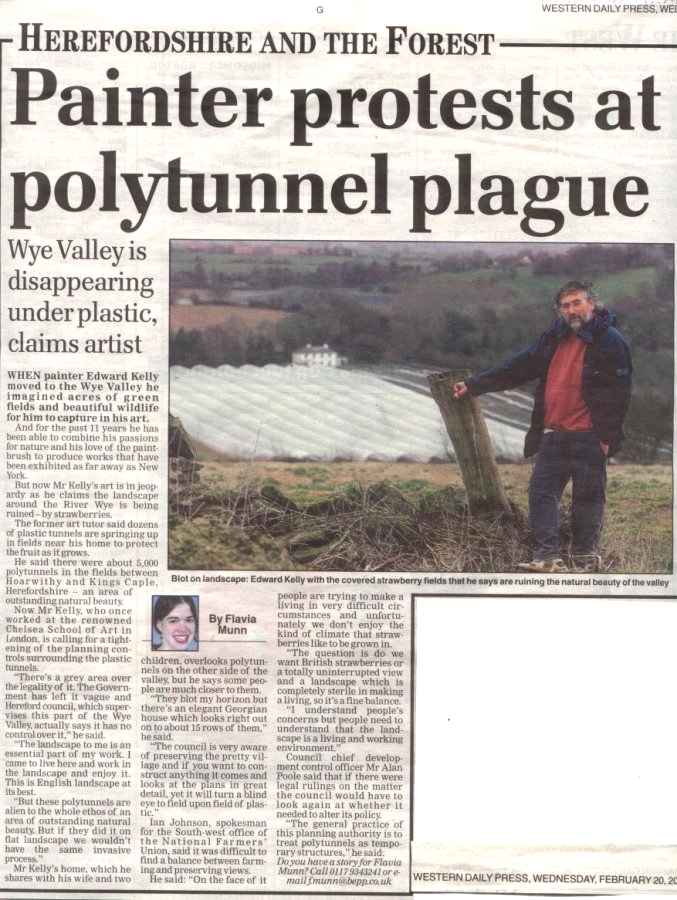

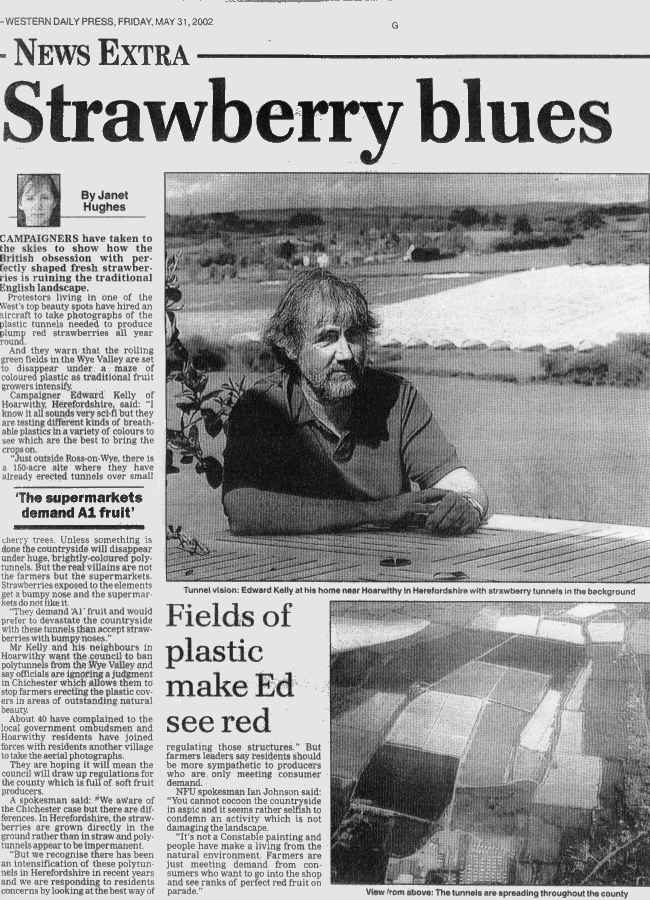
Revealing the colossal destructive impact of polytunnel industrial work sheds on Herefordshire’s finest landscape. Each pictures is but a section of a site. Polytunnels are used to provide class “A” strawberries demanded by supermarkets. The dark fields show hoops over plastic ground cover prior to the raising of the white plastic outer skin of the tunnels.
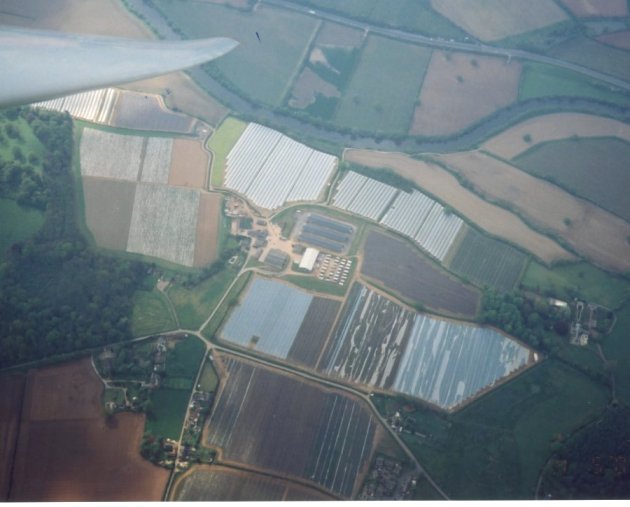
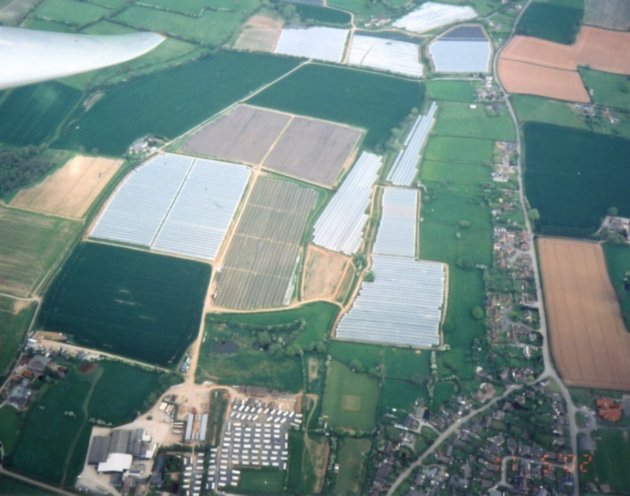
HEREFORDSHIRE THE
MECCA OF PLASTIC DESPOILATION polytunnels popping up
“willy-nilly”,.
Other sites are at; Much Birch, Sutton Marsh, Withington Marsh, Bush Bank, Pencoyd Canon
Pyon, Ashford Carbonell, Ledbury, Weston Penyard, Eywas HaroldNot however in the rest of
England, they employ sensible controls.
By contrast, Hereford planning decided that a shed of “Wendy House “ proportion larger than ten cubic metres sited in Hoarwithy may be detrimental to the Area of Outstanding natural beauty. Our village is surrounded by polytunnels ONE HUNDRED and SIXTY ONE THOUSAND SEVEN HUNDRED & EIGHTY NINE TIMES larger than the 10 cubic metres considered harmful to the Area of Outstanding Beauty. Mrs Rathbones “Wendy house” is hidden in the rear garden, polytunnels are destroying the open valley and village environment but require no planning consents a “ Wendy house “does. Such is the absurdity of Hereford planning do we assume that if a” Wendy house” was a hundred and sixty thousand times larger and seen from the air it might also evade their attention.
A Kings Capel fruit farmer is facing local opposition over his plastic covered
"polytunnels" which he uses to farm strawberries.
Neil Cockburn of Pennoxstone Court, supplies supermarkets with early strawberries and he
says he needs the protection for the spring.
Ed Kelly a landscape artisr from Hoarwithy whose home overlooks the feilds has complained
that the tunnels ruin the countryside.
He is planning a petition based on Hoarwithy residents in the Wye Valley Areas of
Outstanding NaturalBeauty,although he claims it will not be naming any particular farmer.
"Problem"
He says he believes that the use of tunnels is a problem he has encountered throughout
Britain and Europe." It's realy awful" he said But people have a blind spot
because it's farming.
Andrew Blake from the Wye Valley AONBadded" It is a tricky one. They are not
particularly attractive features ,but are for a perfectly appropriate agricultural
activity.He noted that farmers did not need planning permission because they are not
permanent structures."Farming has a revered place in legislation " he said.
Mr Cockburn said "I wasn't aware that anyone didn't like them .I put them up as late
as possible and pull them down as soon as possible. The supermarket insist we do it.
"I am very happy to talk to any one who has concerns about it" He added this
years tunnels will be removed at the start of July.
Andrew Blake then knew of the Brinkman versus Chichester appeal , he declares his
knowledge in his letter dated 7th Marc2002 "I was aware in 1998 0f a fortcoming
Public Inquiry in Chichester"
he villages of Hoarwithy had repeatedly expressed Their concern
Whilst some tunnels might be removed in July as Mr Cockburn indicates others remain
and this is an all year round blight year upon year.
Madam ,We have for many years made twice -annual visits to Herefordshire staying near the village of Marden and enjoying the very pleasant countryside in this part of the country. However on our last two or three visits we have been horrified to see much of that area strewn with the most ugly structures of large metal hoops, in summertime covered in unsightly plastic.
We understand that this is an intensive form of strawberry growing,but it seems to us the natural beauty of the area is being sacrificed to this .These wretched structures appear to be sited close to homes and gardens and must cause great stress to all who previously enjoyed an unobstructed view.
We are told harvesting the strawberry crops entails much
disturbance and noise from vehicles and people when the villages are trying to get a
night's rest .
The development is surely something the local authority can , and should seek to control.
MADAM, Straw berry feilds forever (P Hoskins letter December 20); The natural beauty of
the area is being sacrificed by hoops covered in plastic. The development is surely
something the authorities can, and should control.
Our council does not have powers to control polytunnels structures of a temporary nature
,with no concrete footings .these temporary structure last for nine months from December
each year.
Tourism, holiday cottages and guesthouses will suffer because who will want a vacation
overlooking plastic hilst listening to the noise of river pumps ?I am sure the value of my
house with unparalleled views of polythene ,will drop. Growers claim they help the local
economy ,but vast numbers of workers are drawn from Eastern Europe.
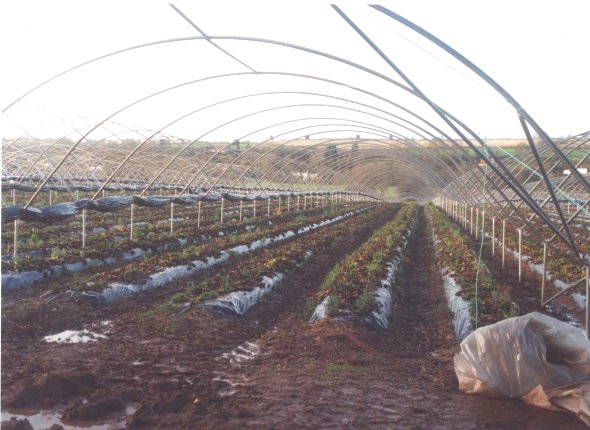
photo: published in Hereford Times article, "Blot on beautiful face, or necessity"
MADAM, (P Hoskins letter Dec 20) “These wretched structures appear to be sited close to homes and gardens and must cause great distress to all who previously enjoyed an unobstructed view”
Yes, they do cause stress. Twelve years ago I was enamoured by the unspoilt beauty of the Wye Valley and resigned from teaching Painting at Chelsea School of Art to live and paint in this landscape
Once one of the most beautiful areas of the Wye Valley between Kings Caple and Hoarwithy has now become a white plastic wasteland, two to five thousand hoops per field, mile upon mile of polytunnel. It is sad to witness each year more green fields being lost to this plastic blight.
The government could have acted, and in their recent white paper, brought farming in AONB, s firmly within planning controls. The Dept of the Environment has left the legality of these structures uncertain, it states whether polytunnels fall within present planning controls is ultimately a matter for the courts. Hereford Council interpret that they have no controls There is a conflict here, whilst exercising strict planning regulations of all building development to preserve and enhance the pretty village,pollution on grand scale is given free reign in the surrounding environment However New Legislation exists( “Skerrits of Nottingham Ltd v. Secretary of State for the Environment March 22 2000) and forms the basis for control.
This I now discover was provided six months ago to the council by a solicitor making representation for a community of Marden also experiencing polytunnel blight. I myself have written four times to the AONB offices and received not even an acknowledgement; it must be tough to adhere to the opinion that this still remains an Area of Outstanding Beauty. The parish council s of Ballingham Bolstone and Hentland have written to Paul Keetch with the resolution, ”Structures of a temporary nature such as Poly Tunnels that do not fall within the current constraints of planning procedures should be subject to appropriate controls to protect sensitive areas such as “Areas of Outstanding Natural Beauty” The Farmers continue to erect tunnels in open valley beside the flood plain and surrounding houses, obliterating more views. Blame is on the demands of the supermarket; the supermarket in turn claims it is only responding to the wish of the public to eat strawberries out of season.
(Peter Simkins, chairman of The Friends of Hoarwithy Jan 10) ”Tourism, holiday cottages and guesthouses will suffer because who will want a vacation overlooking plastic whilst listening to the noise of river pumps?” Indeed walking and enjoying tranquillity and historic sites is the main attribute of the AONB. Polytunnels form a prominent year round blot seen for miles on roads and footpaths. Who enjoys seeing Kings Caple church besieged with tunnels or the river with pounding pump?
Apart from not eating strawberries what can we do about it? Write to them all, include Paul Keetch MP. One representative of the National Farmers Union responded “ if you think your valley looks like a lake then the south of Spain looks like a sea” Do we allow this to be the future of the most glorious English landscape?
Screening 11th March 2002
Statement made by Edward Kelly, Painter.
Filming of studio work and practice set in a landscape now
covered in plastic
As a painter I came here to live and work in the Wye Valley. I chose this because it is
amongst England’s best landscape second to none.
The River Wye is a main geographical feature. Here alongside the river, the valley is
at its finest and most sensitive, now it is being destroyed by plastic. My objection is
not just for me but also for everyone who lives and visits this area.
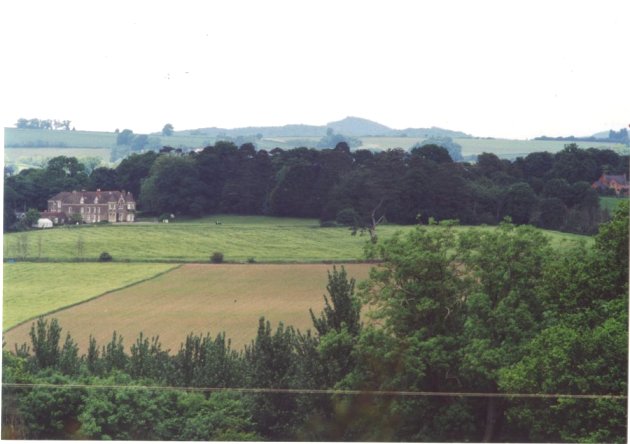
photo: Pennoxstone Court Kings Caple, Residence of Mr Cockburn
*Family*
e-mail received 13th January 2003
"I am a Parish Councillor in Kings Caple, but I am not the landowner of Any
land where polytunnels are erected,nor derive any income from any of The farming
enterprises undertahen by other members of my family throughout parts of Herefordshire.The
site states a disproportinate representation by "farming community" there is,
suprising for the region only one full-time farmer on this small rural Parish
Council"
I am an international satelite telecommunications engineer and also Choose to live in this
most lovely part of South Herefordshire.Is there a disproportinate representation of
electronics engineers on this Parish Council too???
Yours sincerely
Philip N Brandram Jones MBE
Minutes
from Kings Caple Parish Council 28th January
(in response to a proposed resolution for controls over polytunnels to protect
both landscape and residents)
"Mr David Jenkins ,as a landowner with polytunnels on site, declared an interest and
signed the pecuniary/ Non Percuniary Interest Book.
Councillors agreed that such constraints would kill off active enterprise and noted that
the activities associated with polytunnel farming within the village were in general ,of
benefit to the village" A letter was forwarded to Paul Keetch.
In
response to Philip Brandram Jones objection regarding "disproportinate"
farming representation we make the following observation.
One parish councillor has land on which the polytunnels stand ( He signs the pecuniary
Interest Book)
One parish councillor has "family" land on which polytunnels stand.
Other councillors are not "fultime" farmers.
Normaly on a small parish council there are four councillors How many councillors are on
this parish council?
With the exception od David Jenkins these councillors do not live near and still enjoy
"still this most lovely part of Herefordshire". They do not daily
wtness the devastating effect of these polytunnels or apparently care They
write to the MP to actively promote further development..
For further information Herefordshire Council offer address ::J Powell ,Kins Caple PC,
Westnor Farm ,How Caple ,Herefordshire HR1 4RR
Considering that only 7% of people in Herefordshire work in agriculture and only a very small percentage are also landowners .stating that there is "disproportinate representation" is an understatement..
The
residents of Kings Caple were largely ignorant of what action the council were
taking to actively promote this "enterprise"
and went on to make formal complaint to the Ombudsman ,see "Peoples Voice" and
following letter.
15th April 2002,
Madam, Ms penny’s contention that intensive farming is the only
way to survive is laughable. Tell that to the Prince of Wales a committed campaigner
against such farming methods who has introduced his own range of organic produce.
These monstrous polythene tunnels polluting this once beautiful
countryside around Kings Caple are not growing food for the benefit of the people. They do
not provide work for the locals as those who work in them are imported from Eastern Europe
all they do is turn the village into the rural equivalent of an industrial
estate…Herefordshire will lose an important source of its income tourism. Take away
this county’s beauty and what reason is there to visit it?
The increasingpopularity of organic fruit and vegatables that actualy have some sort of taste provesc that we are becoming much more discriminatin about what we eat.Lets hope that sooner or later the message will perculate through to the farmers
MADAM, I'd like to support Edward Kelly's letter today about the hideous spread of
polytunnels by citing an even worse example.
The view of Hergest Ridge from the south has been completely destroyed by very extensive
polytunnels at Huntington.
Hergest Ridge is one of the greatest sights ont he Welsh border, and the whole area one of
the most beautiful in Britain. If the council doesn't wake up soon, the area wil be
comprehensively wrecked.
Incidentally the soil beaneath the polytunels is covered in black plastic and its natural
life suffocated. These tunnels are both ugly and appalling farming practice.
A group of Ross residents are campaigning to outlaw the widespread method of growing top quality strawberries under polythene by taking their complaints to the local ombudsman......Some residents of Hoarwithy have expressed their concern regarding the loss of the valued landscapes of the Wye Valley and have highlighted the impact on tourism,given the former glory of this once beautiful environment.The objectors have compiled aerial photographs and individual responses to the destructive impact of polytunnel industrial work sheds on Herefordshires finest landscape.......Neil Cockburn pointed out that one of the main benefits of the tunnels is that they provide rain protection "The varieties that we are being asked to grow for the supermarkets have very good flavour but are more susceptible to damage by heavy rain",........
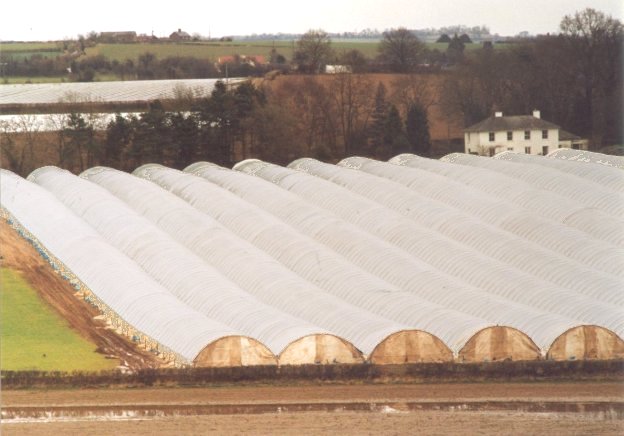
photo: appeared in The Ross Gazette, "Why destroy our most glorious landscape to produce a strawberry without a bumpy nose?"
20 June 2002
"WHY DESTROY OUR MOST GLORIOUS LANDSCAPE TO PRODUCE A STAWBERRY WITHOUT A BUMPY NOSE?
Your article 13th June 2002 raises the issue of polytunnels in the landscape and gives single voice to polytunnel/ strawberry businessman Neil Cockburn but what of the thousands of people adversely effected in Herefordshire.To this end I give voice as one of that silenced and deprived majority
Hereford Planning considers polytunnels are “temporary structures”, this means no one has a legal right to object. Classed, as “temporary structures” they will not look at visual impact on landscape. They will not look at visual impact because they are classed as “temporary structures”, this perverse logic is more akin to the cult novel Catch 22 than a responsible planning authority
Why destroy our landscape for a strawberry without a bumpy nose.
Is this also a novel fantasy? Imagine a situation where the need to grow food is so
desperate that a large immigrant workforce has been transported to live on site, in labour
camps with primitive conditions. Enormous plastic tunnels are being constructed around
homes, which previously enjoyed panoramic views across open countryside
What catastrophe could possibly warrant such extreme measures? War
torn Britain where democracy has been suspended in the urgent need to provide food for the
nation? A third world country threatened by famine?
Sadly, no. This is happening here in Herefordshire 2002 .At Marden once nominated best
kept village distressed owners flee these previously desirable homes now surrounded in
polytunnels You might expect the democratic institutions would be outraged and quickly
right this obvious abuse
Development is now in the heart of the
Wye Valley AONB, at Kings Caple alongside the main geographical feature in Herefordshire
the river itself, in open valley and amidst historical buildings, the most sensitive
location in an area of great landscape value, site of special scientific interest.
The residents of cottages in the picturesque Hoarwithy village hugging the high west bank
of the river once enjoyed a vista of apparelled loveliness, born from centuries of care.
Now they are compelled to look out across a white wasteland, field upon field of billowing
plastic sheet and hideous polytunnel, surely the most visual polluting agricultural method
ever.
I have a letter from Sainsburys
which reads “We do purchase strawberries grown in polythene tunnels from the Wye
valley,- I assure you we do pay close attention to the environmental impact of everything
we do”
I would simply add to Mr Kelly’s comments that it is not only those living within
sight of this devastation who are appalled, but those who come to visit or who pass
through the valley and admiring its beauty, vow to return. Who would want to stay–in
or return to such magnificent riverscape, which has been vandalised in this way?
Undoubtedly the most important resource we have in this part of the county is its natural
beauty. Polytunnels and plastic sheets are spreading like an ugly uncontrollable rash
destroying what is a God given asset. As if the set backs caused by the effects of foot
and mouth were not enough, we now face the pernicious disease of shortsighted greed. Are
we to allow the authorities (remember, we elected them) to permit this continued
devastation by a handful of insensitive landowners? Do we really want to see our lovely
pastoral inheritance suffocated under a shroud of plastic?
If the AONB has any meaning at all then those who’s function it is to be “conserve and enhance the natural beauty” of the valley should be seen to be putting pressure on those responsible for its destruction. -And we should all be concerned for the sake of generations to come.
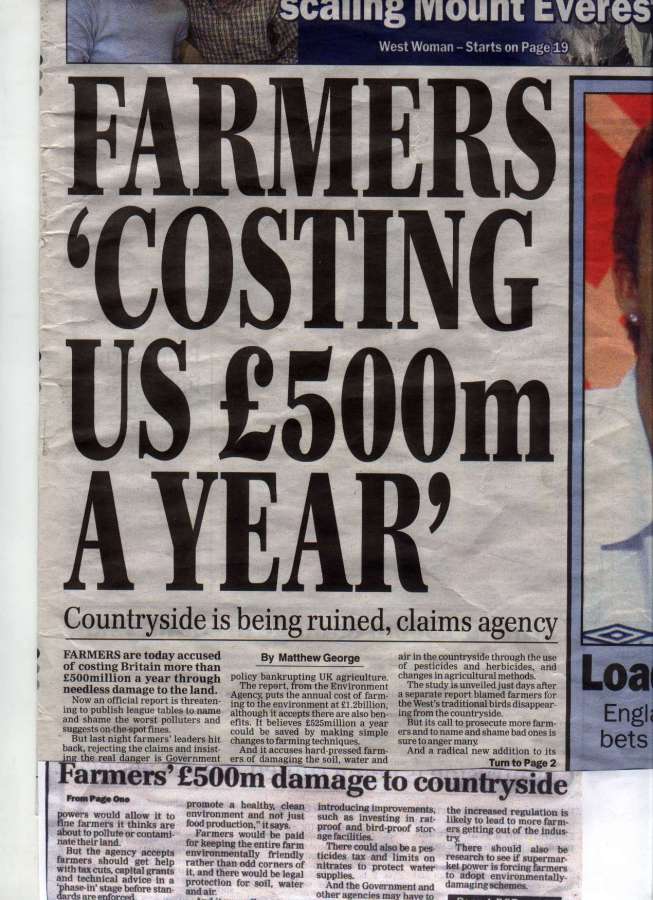
Angus Davison, The 37-year old who founded the
world-renowned Haygrove Fruit at Pixley supplies strawberries to al the UK's main
supermarkets and is the major supllier of polytunnels across the world.
But the innotative entrepreneur say'she was "absolutely horrified when he heard about
his MBE"..
Angus Davison confirmed that he attended the appeal hearing in Brinkman Brothers against Chichester County Council he was then the supplier of the polytunnel that Chichester ordered to be removed from their AONB.,the very same type of "Spanish " polytunnel now devastating Herefordshire
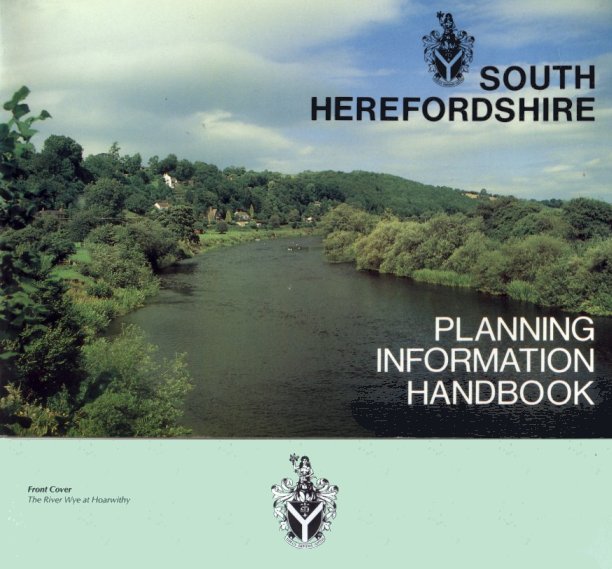
Unpublished letter,
to press, by David Kennedy, Hoarwithy resident
"Planners destroy the gem
South Herefordshire Planning Information Handbook Front Cover proudly presented a picture
of what was once considered the gem of the Wye valley Area of Outstanding Natural Beauty,
the river Wye at Hoarwithy. If they now turned their camera 90% they would behold seventy
acres of plastic and polytunnel. This has destroyed the environment of this once beautiful
village.
Hereford Council by their insistence that polytunnels are temporary structures requiring no planning consents has wreaked havoc on our county. In the planning handbook they say” the primary aim is to conserve and enhance the area’s natural beauty, the council will give priority to the protection of the landscape and its existing features”
In a policy statement relating to building regulation they state” Prominent views to and from hillsides and across open countryside or towns are protected from the intrusion of large scale development .The setting of historic and attractive man -made features such as cathedrals, churches and notable buildings should therefore be protected “
They have ignored three of the prime directives controlling all other planning issues because polytunnels do intrude into prominent views from hillsides they are of immense scale, larger than any industrial estate you might imagine, they stretch across open countryside and they invade the attractive setting of notable historic Hoarwithy church whilst physically surrounding the church at Kings Caple.
By contrast the planners reject permission for a small conservatory restaurant extension to our village pub apparently its tiny foundation decreased the absorbency of the flood plain whilst the enormous rainwater run off from acres of plastic is ignored.
This policy is mad, totally wrong and irresponsible. Hereford council have denied the democratic right for individuals aggrieved to assert a view that covering vast areas of landscape with plastic sheet and polytunnel should in no account what so ever be allowed within an AONB.
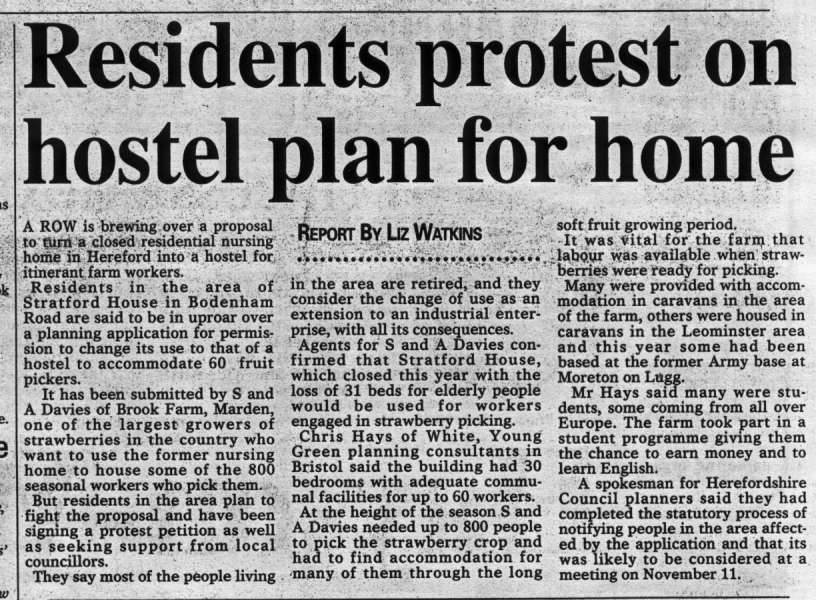
Anyone who doubts the environmental
impact of the unfettered development of agricultural polytunnels should take a trip
into the Almeria region of south-east Spain.. About fifteen years ago somebody had the
bright idea of using plastic green houses to cultivate salad crops on arid plains so
reminiscent of America's wild west that Italian film director Sergio Leone made his so
called "spaghetti" westerns there back in the 1970's.
If Clint Eastwood-the man with no
name -returned to ride the same plains today he would have to navigate a virtual sea of
plastic now spanning more than 40,000 hectares, a blot on the landscape so massive that it
can clearly be seen from space. Ten thousand polytunnels some as big as football pitches
send tomatoes, peppers and melons to the supermarkets of northern Europe in a business
worth an annual 1.2 billion Euros.
Farming families who once hardly
scraped a living from the red sandy soil have become millionaires in less than a
generation as the almost deserted region attracted tens of thousands of immigrant farm
workers from Morocco.
But the ecological price has been
high. In an area with Europe’s lowest rainfall the salad farmers bored thousands of
wells so deep that seawater was sucked into the water table and the local supply now
suffers from high salinity. In some areas the greenhouses are so close to the beaches that
tourists are discouraged.
Members of Herefordshire County
Council's environmental panel are wise to be considering tighter planning regulations for
polytunnels. There seems to be a clear economic case for strawberry growing under plastic,
given the creation of 750 full time jobs in the county.
Compared with south -east Spain a
mere 300 hectares of polythene in Herefordshire is hardly a big problem. But 20 years ago
there was none on Almeria.
The welfare of the farming community
needs to be carefully balanced against the effect unregulated growth of such methods will
have on tourism in one of Britain’s most beautiful counties.
Aesthetic impact should be high on
the list of considerations-acre upon acre of polythene is not a pretty sight.
Any large -scale development should be judged on the impact it will have on the landscape.
If it is going to be a blot, planners should say no or at least insist on suitable tree
planting schemes to hide the greenhouses.
(Jeep traveling for mile upon mile through the feilds of polytunnels of Almeria southern Spain)
The impact has been such that it has resulted in the extinction of the Lynx . This is the fastest recorded effect on the extinction of a species.

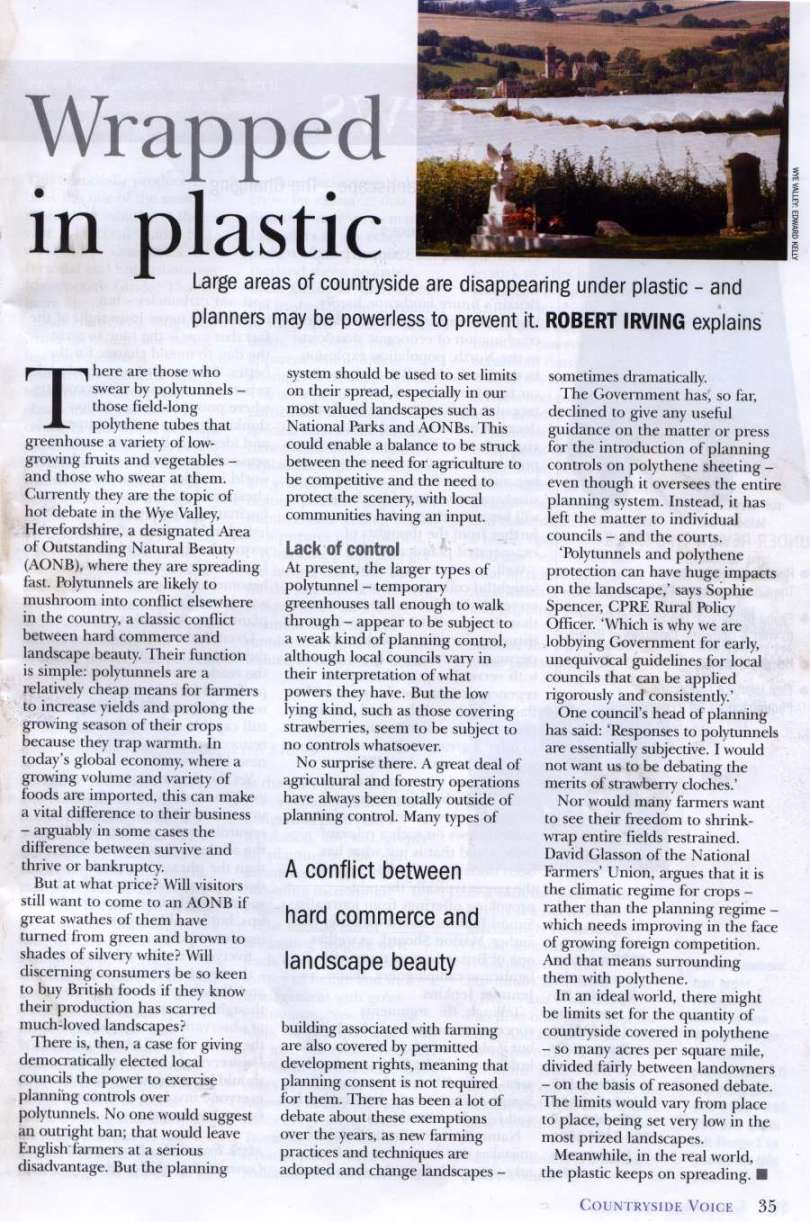
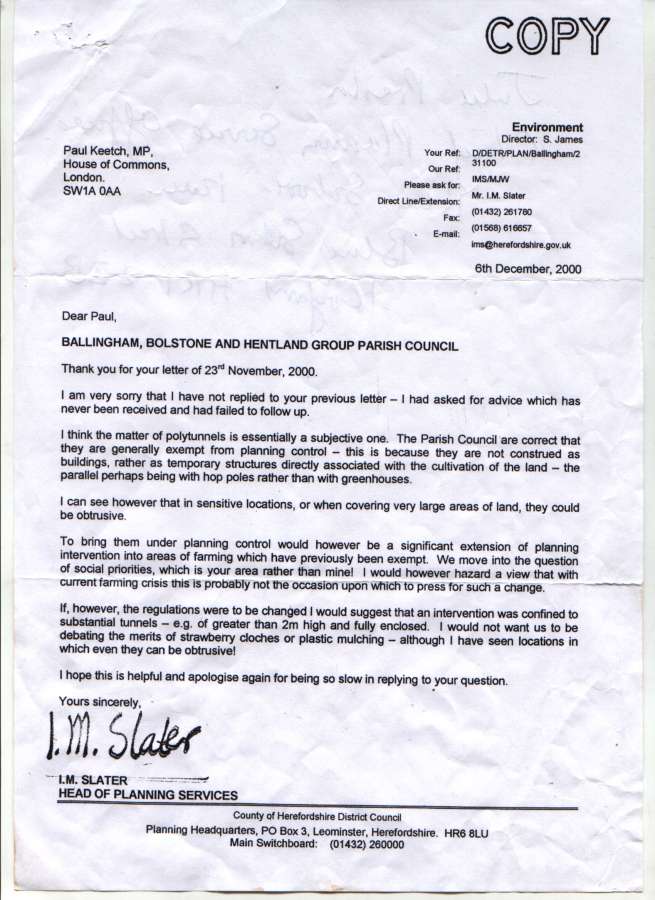
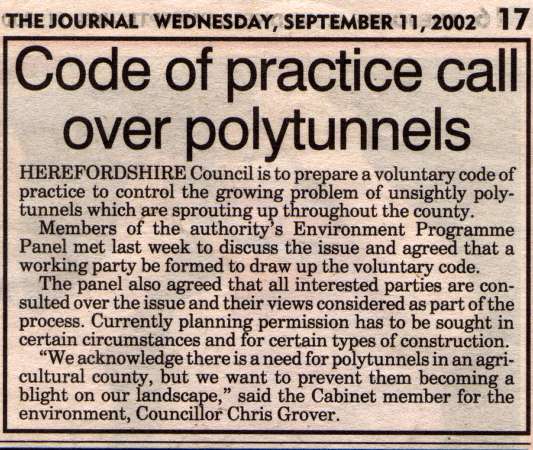
One aspect of the
Voluntary Code” in Herefordshire’s answer to the plague of polytunnel
development that has all but destroyed three of the riverside hamlets in the Area of
Outstanding Natural Beauty is that relating to the distance that polytunnels may be
erected from a persons home .The distance of thirty metres is suggested.
Whilst enjoying living in
beautiful open countryside, choosing the open space not the city, suddenly a vast ugly
plastic industrial development is placed around your home the size of a small town. You
are encased all views gone, and of course you have no legal right for a view, you are
however allowed a thirty metre measure from the walls of your home, and with the courtesy
of the council a rope from which to hang.
It is totally unacceptable
that the ensnared victim should suffer the indignity to have either the grower or the
planners scrambling over the garden measuring from the house wall not even allowed the
defence of a garden. The grower is being allowed to exert his anti social activities
beyond the garden boundary
Although only seven per
cent are employed in agriculture in this county they exert a strangle hold on the council.
Hereford times Nov 28th featured the success story of a further £60,000
government grant for further and permanent development of this polyblight within the AONB.
6th Dec 2002
BBC Wednesday, 7 August, 2002,
13:00 GMT 14:00 UK
The Spanish government
says the water is needed for the agribusiness sector that covers much of southern Spain in
a sea of polytunnels and plastic sheeting.
A
multi billion Euro scheme designed to divert water from Spain's rainy north to it's
parched south is dividing the Spanish nation. This has provoked over a million protesters
to take to the streets in one of the greatest public displays of anti-government sentiment
in Spain since the days of General Franco. Vicente Sicilia's produce will undoubtedly
benefit from the water flow
To
him the Spanish government's National Hydrological Plan makes perfect sense.
"Here
in Murcia we've got a wonderful climate, good land and hard working people. There's just
one thing missing - water". The idea is to siphon off "excess water" from
the River Ebro, which springs in the Pyrenees and ends just south of Barcelona.
This
thirsty greenhouse economy, which relies heavily on cheap immigrant labour, has brought
new wealth to dry and formerly impoverished areas like Almeria and Murcia.
President
Valcarcel, a fervent supporter of the National Hydrological Plan, also argues that the
agribusiness sector plays a vital social role by providing immigrants from North Africa
with stable work.
"Every
year the river just throws away 13,000 hectolitres into the Mediterranean Sea and we're
just asking for a small part of that water which is wasted", he says.
If
the multi million Euro plan goes ahead, it will be the most ambitious infrastructure
project in Europe. But its critics see the plan as outdated, environmentally destructive
and mired in scandal. They say it is a project designed by and for the construction
industry - an industry that has disturbingly close links to Spain's political elite.
Spain's
water politics will be broadcast on Thursday 8 August 2002 on BBC Radio 4 at 1100 BST.
Repeated on Monday 12 August 2002 on BBC Radio 4 at 2030 BST.
Reporter:
Julian Pettifer
Producer:
Lucy Ash
Editor:
Maria Balinska
http://www.bbc.co.uk/factsheets/countryfile/prog_2423.shtml
10:00-10:30
128 Southwark Street,LondonSE1 OSW
htto//www.cpre.org.uk Tel 0207 981 2800
www.geocities.com/polytunnelcontrol
Visiting from London the site at Kings Caple Wye Valley AONB
"As polytunnels roll out across the landscape they threaten our National Asset the
ladscape.It is obviously having visual impact and in turn thse rural areas will suffer
economically.The foot and mouth crisis taught us to realize the economic sense and
importance of caring for our landscape"
Large areas of our most beautiful landscape buried under semi permanent plastic.
Mr
Snell Herefordshire fruit grower business at Pencoyd NOT in the AONB
Obtaining planning consents is cumbersome and we need to act quickly when planting a crop.
Unconvincing
excuse ,growers tend to use same field or location indefinitely
Edward
Kelly CPC
Herefordshire planning classing polytunnels as temporary structures allows these to be
constructed anywhere without planning consent to destroy our finest landscapes an AONB
surround a village or be in front of any persons home.
We have strawberries in November but at what cost?
The Wye Valley Area of Outstanding Natural Beauty now an Area of Unnatural polytunnels.
Unless we act now further swathes of our finest countryside will be under plastic.
More
misery for rural economies.
In relation
to the 150-acre polytunnel site at Walford south of Ross on Wye within the Wye Valley AONB
thirty people in the community of Hom Green made complaint against Hereford District
Council for “maladministration” and ”injustice”
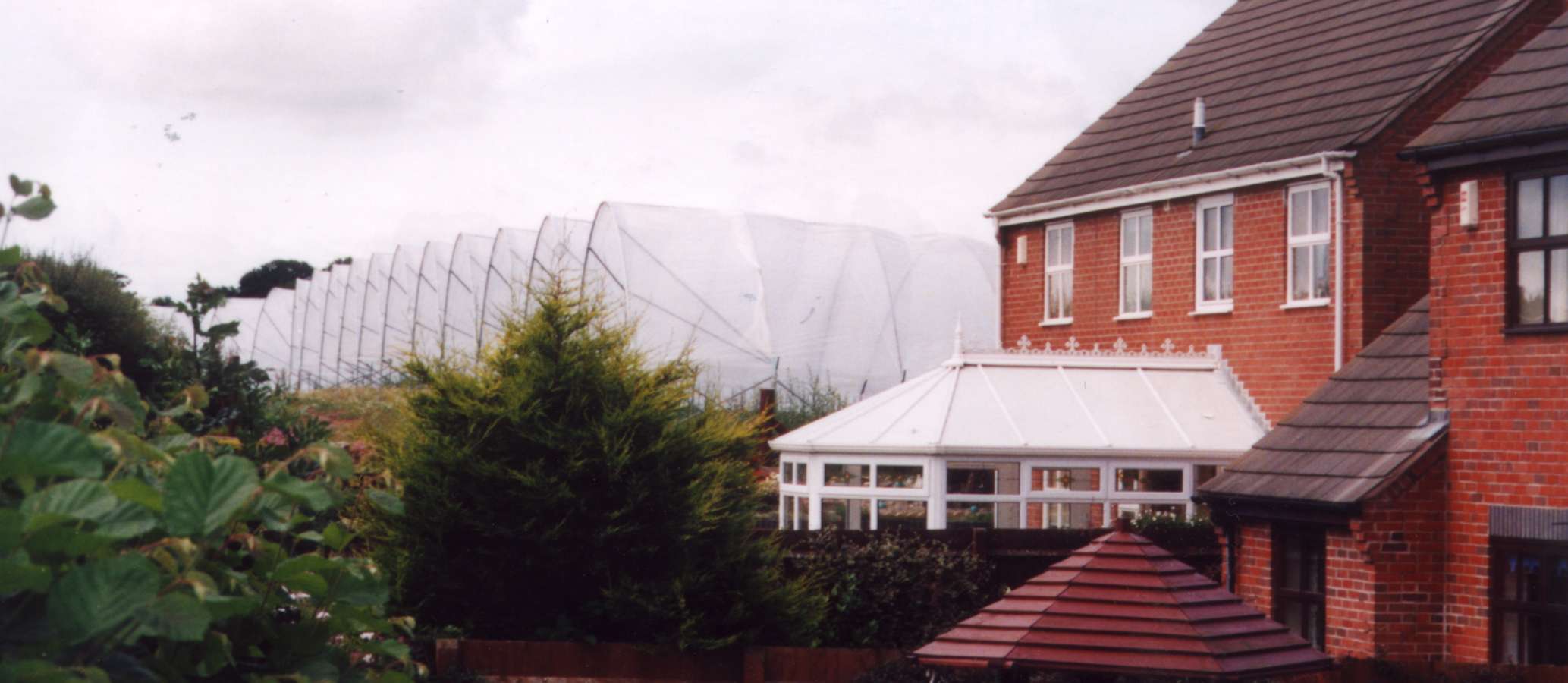
U
Understanding is that Mr Eric Drummond parish councillor on
Walford Parish Council and polybusinessman has now resigned from the parish council
Mr Eric Drummond is now involved in the venture Hartleton Fruit Partnership aiming to
double his turnover in the next three years
Mr Angus Davison the main supplier of
polytunnel in Herefordshire who held the floor at Herefordshire council’s environment
meeting and who no doubt as part of his marketing strategy has been telling growers that
they do not require planning consents is now being asked by Forest of Dean Council
to submit planning consents retrospectively for his own development at Newent.
Mr Davivson has and intends to erect
polytunnels over a rotational crop the very same type of tunnel and the very same method
of production that Herefordshire believes should have no planning consent what so ever
even when in England’s finest landscapes the famous Wye Valley.
Henry Boughton National Farmers Union spokesman,
"They don,t live in the real world ,.people protesting are fat and lazy"
Mr Davison:
"My message to people who critise me is ,This is the real world ,Start living in
it"
Many of these developments receive aid and grants provided by the taxes paid by the very
people Mr Davison so arrogantly attacks.
Both these gentlemen live in the "real World"
The Citizen Dec 2nd 2002 G T Davis Tewkesbury Road Newent
As one of the Tewkesbury Road protesters against polytunnels, I resent Mr Davisons
disparaging remark about our need to get into the real world
I wa serving in the Royal Navy from 1930 1945. Also I happen to know that Nicholas Baker a
fellow protester was in the Royal Marines.
We fought to preserve and protect the heritage of our glorius countryside, not for Mr
Davison to vandalise it with his polytunnels
G T Davis Tewkesbury Road Newent
Chris Wooldrge Tewkesbury Road Newnt.
In reply to your article on polytunnels at Newtown Farm Newent ,I would like to make the
following points.
I am one of the 60 people living in close proximity to Angus Davison,s proposed
"fruit and flower-growing factory"who will be adversely effected by this
development.There is a case for polytunnel developments on small sacale on some sites.This
proposal is on an altogethr different scale part of a huge global agri business that has
little place in sustainable food production systems and more in supplying out of season
luxury soft fruit to supermarket chains
If this planning application is successful it will not be long until the area around Newnt
will be covered in vast sheets of polythene and unsightly steel frames
Perhaps I can supply some real facts on polytunnels based on current
practice just down the road in Herefordshire a county that doesn,t consider planning
permission is neccessary for these plastic roofed factories.
Incidentaly some of Mr Davisons tunnels have already been errected.in Newent
Polytunnels are effectively permanent Once installed they remain on site until the either wind blows them away or agricultural policy changes
The frames can not be moved economicaly with the crop
Polytunnels are dangerous when sited near homes.High winds can and have lifted the plastic and the frames into the air ,have done structural damage and brought down overhead telephone and electric lines.
Polytunnels blight large areas of once attractive landscape ,turning away tourists and ruining residents views.
Polytunnels of this scale create flash floods and major drainage problems.
Polytunnel shemes provide few local job opportunities.Most installations are serviced by casual immigrant labour.
Polytunnel schemes like this destroy habitats of endangered wildlife species and threaten fragile eco-systems
Polytunnel crops of this scale are worked around the clock,substantialy increasing traffic noise and sleep disturbance.
I could go on
No ,MrDavison, Idon,t want to live in your "real World" of strawberries in November ,but in my real world where the sound of birdsong can still be heard and where good quality seasonal food is grown in a comminity that people want to live in and come to visit.
Meanwhile back in darkest herefordshire where democracy is stifled in 2003
"There are two sides to this problem and the opposers will have no say. This is mock democracy,"Peter Simkins Chairman of the Friends of Hoarwithy
The CPC has now obtained barrister oppinion !2th January 2003
As we anticipated this opinion confirms previous solicitor advise that Herefordshire Council are wrong in not implementing the "Brinkman Brothers" decision and the council in its attempts to distinguish between polytunnels using trestle method and those directly over soil is "irrational" and the proposal made within the voluntary code are both "arbitrary" and "irrational"
This reiterates views expressed in the "CPC response to the voluntary code"" 6th December 2002
Click on LEGAL to continue.